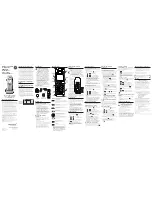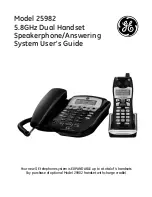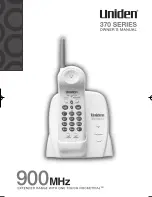
16
KX-TG3661JXM/KX-TG3662JXM/KX-TG3668JXM/KX-TG3669JXM/KX-TGA365JXM
4.7.
Circuit Operation (Cordless Handset)
4.7.1.
Outline
Cordless Handset consists of the following ICs as shown in
Block Diagram (Cordless Handset)
(P.14).
• BBIC (Base Band IC): IC1
- FHSS
- All interfaces (ex: Key, Detector Circuit, Charge, DC/DC Converter, EEPROM, LCD)
• RF IC
- Transceiver IC including LNA, PLL, demodulator, logic IC301
- PA (TX power amplifer) IC300
• EEPROM: IC2
- Temporary operating parameters (for RF, etc.)
4.7.2.
Power Supply Circuit
Circuit Operation:
When power on the Cordless Handset, the voltage is as follows;
BATTERY(2.2 V ~ 2.6 V)
→
L101, D100
→
Q302 (1.8 V)
→
Q303 (2.5 V).
The Reset signal generates IC1 (53 pin) and 1.8 V.
4.7.3.
Charge Circuit
Circuit Operation:
When charging the cordless Handset on the charger, the charge current is as follows;
AC Adaptor: DC+(6.5V)
→
(charger)
→
(cordless Handset)
→
Q503
→
D501
→
Vbat (+)
→
BATTERY--
- Vbat (-)
→
R500
→
GND
→
CHARGE- (Cordless Handset)
→
CHARGE- (charger)
→
GND
→
DC- (GND)
In this way, the BBIC on Handset detects the fact that the battery is charged.
The charge current is controlled by switching Q500 of Handset.
4.7.4.
Battery Low/Power Down Detector
Circuit Operation:
“Battery Low” and “Power Down” are detected by BBIC which check the voltage from battery.
The detected voltage is as follows;
• Battery Low
Battery voltage: V (Batt) < 2.3V ± 50mV
The BBIC detects this level and "
" starts flashing.
• Power Down
Battery voltage: V (Batt) < 2.1V ± 50mV
The BBIC detects this level and power down.
4.8.
Circuit Operation (Charger Unit)
4.8.1.
Power Supply Circuit
The power supply is as shown.
R1
TP2
TP1
J1
AC Adaptor
D1
















































